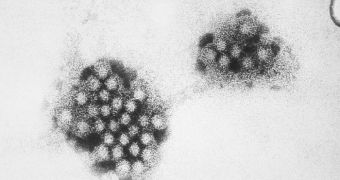Using nanoparticles as vaccine carriers is part of a new strategy of developing a vaccine against norovirus, one of the most frequent causes of food poisoning in the United States.
Gastroenteritis – also called stomach flu (even if it has nothing to do with influenza), is an inflammation of the lining of the intestines caused by viruses, bacteria or parasites.
Viral gastroenteritis is the second most common illness in the US, and it spreads through contaminated food or water, and contact with an infected person.
The two main causes of acute gastroenteritis are rotavirus and norovirus, and the former causes severe diarrhea in children, killing an estimated 527,000 worldwide, every year.
Norovirus is a very contagious and very unpleasant flu, that can cause up to three days of vomiting and diarrhea in healthy adults, and that kills 200,000 children each year.
It has become very common for vaccine developers to use nanoparticles as carriers of small peptide antigens, so it's nothing unusual that a team of researchers led by Xi Jason Jiang of Cincinnati Children’s Hospital Medical Center, developed a new nanocarrier, called a P particle, a very promising scaffold for a variety of vaccines.
For their latest study study they inserted rotavirus antigen into the P particle, which resulted in a boosted immune response to rotavirus, as well as norovirus, in mice.
Jiang said that “the dual vaccine holds promise for controlling gastroenteritis in children.”
The P particle’s special feature is being a scaffold, with 24 copies of an outer coat protein from norovirus, according to the American Society for Microbiology.
The nanocarrier actually contains three types of surface loops, and this makes it perfect for presenting a wide variety of antigens.
Also, it is highly immunogenic and stable – a very important feature for use in developing nations.
During the manufacturing process, the antigens can easily be inserted in the nanocarrier, since production consists in expressing the cloned P particle in Escherichia coli.
Besides the rotavirus antigen, the researchers managed to insert a number of antigens into the P particle, than varied in size up to over 200 amino acids.
The vaccines were more effective at reinforcing the immune response in mice, than free antigens.
The resulting vaccines have induced significantly stronger immune responses in mice than have free antigens.
“With the unique features of high efficiency, easy production, and low cost, this new platform will find a broad application in the biomedical sciences,” said Jiang.
The findings were reported in the January 2011 issue of the Journal of Virology.

 14 DAY TRIAL //
14 DAY TRIAL //